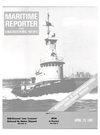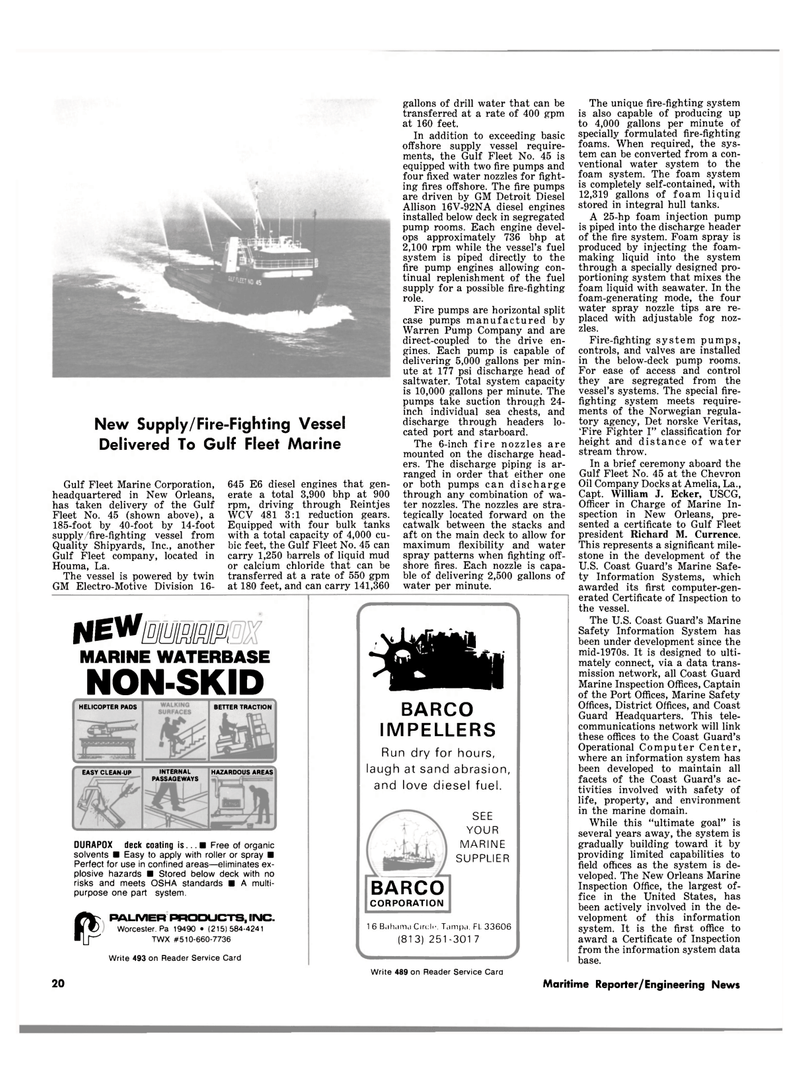
Page 18: of Maritime Reporter Magazine (April 15, 1981)
Read this page in Pdf, Flash or Html5 edition of April 15, 1981 Maritime Reporter Magazine
New Supply/Fire-Fighting Vessel
Delivered To Gulf Fleet Marine
Gulf Fleet Marine Corporation, headquartered in New Orleans, has taken delivery of the Gulf
Fleet No. 45 (shown above), a 185-foot by 40-foot by 14-foot supply/fire-fighting vessel from
Quality Shipyards, Inc., another
Gulf Fleet company, located in
Houma, La.
The vessel is powered by twin
GM Electro-Motive Division 16- 645 E6 diesel engines that gen- erate a total 3,900 bhp at 900 rpm, driving through Reintjes
WCV 481 3:1 reduction gears.
Equipped with four bulk tanks with a total capacity of 4,000 cu- bic feet, the Gulf Fleet No. 45 can carry 1,250 barrels of liquid mud or calcium chloride that can be transferred at a rate of 550 gpm at 180 feet, and can carry 141,360 gallons of drill water that can be transferred at a rate of 400 gpm at 160 feet.
In addition to exceeding basic offshore supply vessel require- ments, the Gulf Fleet No. 45 is equipped with two fire pumps and four fixed water nozzles for fight- ing fires offshore. The fire pumps are driven by GM Detroit Diesel
Allison 16V-92NA diesel engines installed below deck in segregated pump rooms. Each engine devel- ops approximately 736 bhp at 2,100 rpm while the vessel's fuel system is piped directly to the fire pump engines allowing con- tinual replenishment of the fuel supply for a possible fire-fighting role.
Fire pumps are horizontal split case pumps manufactured by
Warren Pump Company and are direct-coupled to the drive en- gines. Each pump is capable of delivering 5,000 gallons per min- ute at 177 psi discharge head of saltwater. Total system capacity is 10,000 gallons per minute. The pumps take suction through 24- inch individual sea chests, and discharge through headers lo- cated port and starboard.
The 6-inch fire nozzles are mounted on the discharge head- ers. The discharge piping is ar- ranged in order that either one or both pumps can discharge through any combination of wa- ter nozzles. The nozzles are stra- tegically located forward on the catwalk between the stacks and aft on the main deck to allow for maximum flexibility and water spray patterns when fighting off- shore fires. Each nozzle is capa- ble of delivering 2,500 gallons of water per minute.
HS^immm
MARINE WATERBASE
NON-SKID
HELICOPTER PADS
EASY CLEAN-UP INTERNAL
PASSAGEWAYS
BETTER TRACTION
HAZARDOUS AREAS
DURAP0X deck coating is... • Free of organic solvents • Easy to apply with roller or spray •
Perfect for use in confined areas—eliminates ex- plosive hazards • Stored below deck with no risks and meets OSHA standards • A multi- purpose one part system.
VP
PALMER PRODUCTS, IIMC.
Worcester. Pa 19490 • (215)584-4241
TWX #510-660-7736
Write 493 on Reader Service Card ^Ik
BARCO
IMPELLERS
Run dry for hours, laugh at sand abrasion, and love diesel fuel.
SEE
YOUR
MARINE
SUPPLIER
BARCO
CORPORATION 1 6 Bahama Cirri.• Tampa. FL 33606 (813) 251-301 7
Write 489 on Reader Service Card 20
The unique fire-fighting system is also capable of producing up to 4,000 gallons per minute of specially formulated fire-fighting foams. When required, the sys- tem can be converted from a con- ventional water system to the foam system. The foam system is completely self-contained, with 12,319 gallons of foam liquid stored in integral hull tanks.
A 25-hp foam injection pump is piped into the discharge header of the fire system. Foam spray is produced by injecting the foam- making liquid into the system through a specially designed pro- portioning system that mixes the foam liquid with seawater. In the foam-generating mode, the four water spray nozzle tips are re- placed with adjustable fog noz- zles.
Fire-fighting system pumps, controls, and valves are installed in the below-deck pump rooms.
For ease of access and control they are segregated from the vessel's systems. The special fire- fighting system meets require- ments of the Norwegian regula- tory agency, Det norske Veritas, 'Fire Fighter I" classification for height and distance of water stream throw.
In a brief ceremony aboard the
Gulf Fleet No. 45 at the Chevron
Oil Company Docks at Amelia, La.,
Capt. William J. Ecker, USCG,
Officer in Charge of Marine In- spection in New Orleans, pre- sented a certificate to Gulf Fleet president Richard M. Currence.
This represents a significant mile- stone in the development of the
U.S. Coast Guard's Marine Safe- ty Information Systems, which awarded its first computer-gen- erated Certificate of Inspection to the vessel.
The U.S. Coast Guard's Marine
Safety Information System has been under development since the mid-1970s. It is designed to ulti- mately connect, via a data trans- mission network, all Coast Guard
Marine Inspection Offices, Captain of the Port Offices, Marine Safety
Offices, District Offices, and Coast
Guard Headquarters. This tele- communications network will link these offices to the Coast Guard's
Operational Computer Center, where an information system has been developed to maintain all facets of the Coast Guard's ac- tivities involved with safety of life, property, and environment in the marine domain.
While this "ultimate goal" is several years away, the system is gradually building toward it by providing limited capabilities to field offices as the system is de- veloped. The New Orleans Marine
Inspection Office, the largest of- fice in the United States, has been actively involved in the de- velopment of this information system. It is the first office to award a Certificate of Inspection from the information system data base.
Maritime Reporter/Engineering News

 17
17

 19
19
